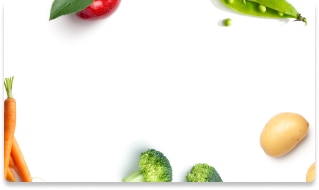
-
Find the right food for your petTake this quiz to see which food may be the best for your furry friend.Find the right food for your petTake this quiz to see which food may be the best for your furry friend.Health CategoryFeatured products
 Adult 7+ Healthy Cuisine Roasted Chicken, Carrots & Spinach Stew Dog Food
Adult 7+ Healthy Cuisine Roasted Chicken, Carrots & Spinach Stew Dog FoodDelicious roasted chicken paired with tender vegetables in a succulent stew
Shop Now Adult Salmon & Brown Rice Recipe Dog Food
Adult Salmon & Brown Rice Recipe Dog FoodSupports lean muscle and beautiful coat for adult dogs
Shop Now Perfect Weight & Joint Support Large Breed Chicken & Brown Rice Recipe Dog Food
Perfect Weight & Joint Support Large Breed Chicken & Brown Rice Recipe Dog FoodThis weight management and mobility support dog food was created with Hill’s unique understanding of the biology of overweight dogs
Shop NowFeatured products Adult Salmon & Brown Rice Recipe Cat Food
Adult Salmon & Brown Rice Recipe Cat FoodSupports lean muscle and beautiful fur for adult cats
Shop Now Adult Perfect Weight with Chicken Cat Food
Adult Perfect Weight with Chicken Cat FoodBreakthrough nutrition for your cat’s healthy weight maintenance and long-lasting weight support
Shop Now Adult Urinary Hairball Control Tender Chicken Dinner Cat Food
Adult Urinary Hairball Control Tender Chicken Dinner Cat FoodPrecisely balanced nutrition to support urinary health from kidney to bladder. With natural fibre technology to help reduce hairballs.
Shop Now -
DogCat
- Cat Tips & Articles
-
Health Category
- Weight
- Skin & Food Sensitivities
- Urinary
- Digestive
- Kidney
- Dental
- Serious Illness
-
Life Stage
- Kitten Nutrition
- Adult Nutrition
Featured articles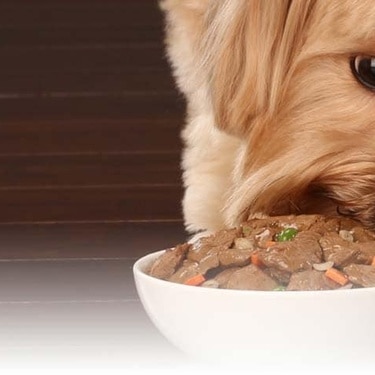 Pet Food Storage Tips
Pet Food Storage TipsWhere you store your cat and dog food can make a big difference in the quality and freshness once it is opened. Here are some common questions and recommendations for optimal storage for all of Hill’s dry and canned cat and dog food.
Read More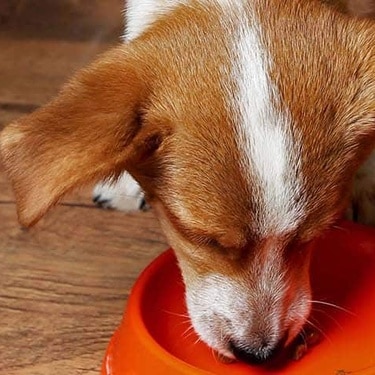 The Right Diet For Your Pet
The Right Diet For Your PetLearn what to look for in healthy pet food & nutrition, including ingredients, quality of the manufacturer, your pet's age, and any special needs they have.
Read More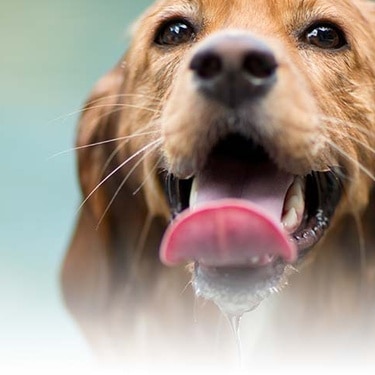 Water
WaterWater is the most important nutrient of all and essential for life. Animals can lose almost all their fat and half their protein and still survive, but if they lose 15% of their water, it will mean death.
Read More -


Water is essential for all life, but how much water should a dog drink to stay healthy? How much water should a cat drink a day? Here are the general guidelines, and how to get your pet to drink more if you are concerned that they aren't drinking enough.
Why Water Matters for Dogs & Cats
Drinking an appropriate amount of water is vital to the health of both dogs and cats:
- 70% of your dog's or cat's body is made up of water
- Water is required for every chemical process in the body
Water is the most important nutrient! Water moisturises the air in the lungs, transports oxygen and nutrients in the bloodstream to cells, helps regulate body temperature, protects and lubricates internal organs and joints, helps to eliminate waste from the body and supports nervous system function.
How Much Water Should a Dog Drink Per Day?
A general rule of thumb for how much water a dog should drink is 1 ounce of fluids per pound of body weight. So a 10-pound dog should drink roughly 10 fluid ounces per day; a 100-pound dog should drink roughly 100 fluid ounces. Yet his may differ dependant on location and activity levels are of your dog.
You may ask ‘how much water should a dog drink who is very active, lives in a hot climate or is lactating?’ The answer in these situations is that those dogs will drink more than other dogs, and puppies will often consume more water than adult dogs. A dog that eats wet food may also drink less water than a dog who eats kibble. These things are all key considerations when understanding how much water your dog should drink.
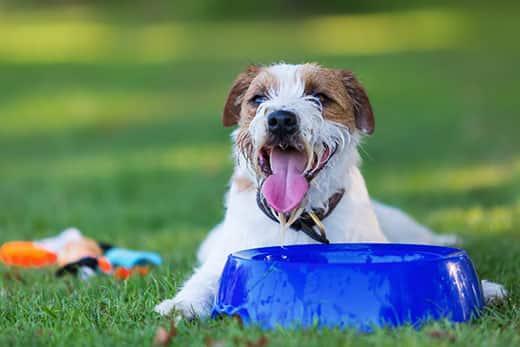
Why is my Dog Always Thirsty?
Drinking too much and peeing too much can be signs of an underlying medical condition in a dog. These conditions may include hormonal disorders such as diabetes mellitus, diabetes insipidus, Cushing's syndrome, kidney disease, liver disease, cancer, fever and infection. Certain medications can cause increased thirst as well. If you notice that your dog is drinking more than usual, it is very important that you make an appointment with your veterinarian.
How Much Water Should a Cat Drink A Day?
Compared to dogs, cats drink less water. In general, adult cats should consume anywhere between 5 to 10 fluid ounces of water per day, depending on their size, activity level, type of food and other factors, such as overall health and ambient temperature. If you feed your cat dry kibble, then they may drink closer to 10 ounces per day, and if you feed them canned food, they may drink closer to 5 ounces because of canned food's high moisture content.


Tasty Tips
Young pets may need several visits in their first year for vaccinations. Adult pets generally benefit from annual check-ups, while senior or special-needs pets might require more frequent visits.
Signs Your Cat is Drinking Too Much
There are key signs that you need to look out for when considering how much water your cat should drink. If a cat is drinking too much, pet parents may notice that they're cleaning out the litter box more often, or that the cat is suddenly hanging out by the water bowl all the time. Many of the reasons a cat will drink too much are the same as in dogs; however, the most common reasons are kidney disease, diabetes, cancer and hyperthyroidism. If you're noticing lakes in the litterbox or your cat is draining the water bowl, then do make an appointment to get your cat checked out by your vet as soon as possible to ensure that your cat is healthy
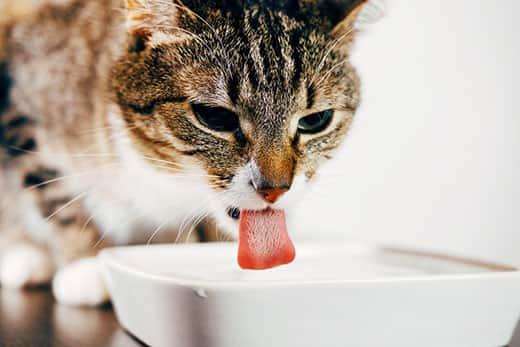
How Do You Know If Your Pet Is Getting Enough Water?
Other than measuring the amount of water your dog or cat is drinking, you can watch for signs that your pet is hydrated. A well-hydrated dog or cat has good skin elasticity (if you pull up on their skin, it flattens down immediately); pink, moist gums, bright, shiny eyes and good energy levels. A hydrated dog's or cat's urine is usually odorless and pale yellow or clear.
A dehydrated dog or cat may be lethargic, their eyes may look sunken or dull, their saliva is sticky or rope-like, their gums are darker and dry and their skin elasticity is reduced. Urine of a dehydrated dog or cat with normal kidneys smells strong and can be dark yellow; however, the urine of dogs or cats with kidney disease can be clear even with dehydration. Severe dehydration can be fatal, so offer small amounts of water and call your vet immediately. These are all reasons why it is important to know how much water your cat should drink.
What to Do If Your Dog or Cat Isn't Drinking Enough
Some dogs and cats won't drink enough, even if you provide all the water they will ever need. Cats are particularly notorious for this, and if your cat isn't hydrating properly, you will need to step in and help to prevent problems associated with dehydration. Try these tips:
- For cats: Try a water fountain. Some cats don't like drinking out of a bowl and instead prefer drinking from moving water. You can purchase cat drinking fountains online or at most pet stores.
- Serve water at room temperature instead of cold, as the temperature may be an issue for your pet.
- Wash bowls often, and make sure water is fresh and clean every day.
- Change the location of the water bowl — some cats are very particular. Try putting the water bowl near a pet's bed or resting location, or a place that doesn't have much foot traffic. Keep it away from the litter box.
- Leave several bowls of water in different areas so that all animals can drink in peace.
- Flavour the water with a small amount of tuna juice, bone broth or chicken broth. Make sure to wash drinking bowls that have been "flavoured" daily. This taste may help encourage your pet to drink more.
- Reward your dog with a treat and/or praise after they take a drink.
- Add water to the food, or supplement your pet's meal plan with canned food.
- Offer your dog ice cubes — they can be great fun!


Dr. Sarah Wooten graduated from UC Davis School of Veterinary Medicine in 2002. A member of the American Society of Veterinary Journalists, Dr. Wooten divides her professional time between small animal practice in Greeley, Colorado, public speaking on associate issues, leadership, and client communication, and writing. She enjoys camping with her family, skiing, SCUBA, and participating in triathlons.
Related products

Supports lean muscle and beautiful fur for adult cats

Supports lean muscle and beautiful coat for adult dogs

This weight management and mobility support dog food was created with Hill’s unique understanding of the biology of overweight dogs

Precisely balanced nutrition to support urinary health from kidney to bladder. With natural fibre technology to help reduce hairballs.
Related articles
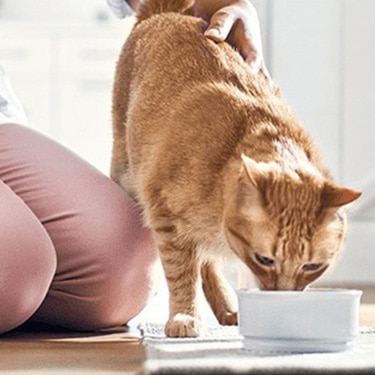
Show some love with wet foods: a great choice for pets with health issues.

Water is the most important nutrient of all and essential for life. Animals can lose almost all their fat and half their protein and still survive, but if they lose 15% of their water, it will mean death.

Learn what to look for in healthy pet food & nutrition, including ingredients, quality of the manufacturer, your pet's age, and any special needs they have.

Where you store your cat and dog food can make a big difference in the quality and freshness once it is opened. Here are some common questions and recommendations for optimal storage for all of Hill’s dry and canned cat and dog food.

Put your pet on a diet without them knowing
Our low calorie formula helps you control your pet's weight. It's packed with high-quality protein for building lean muscles, and made with purposeful ingredients for a flavorful, nutritious meal. Clinically proven antioxidants, Vitamin C+E, help promote a healthy immune system.
Put your pet on a diet without them knowing
Our low calorie formula helps you control your pet's weight. It's packed with high-quality protein for building lean muscles, and made with purposeful ingredients for a flavorful, nutritious meal. Clinically proven antioxidants, Vitamin C+E, help promote a healthy immune system.

